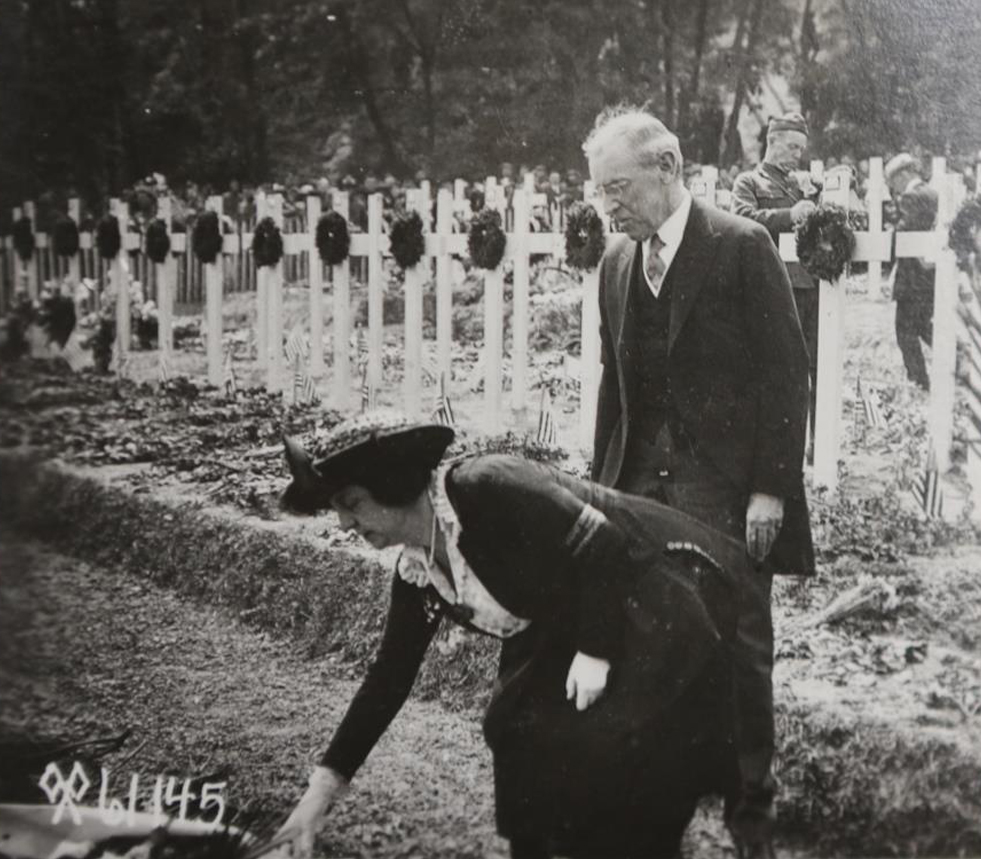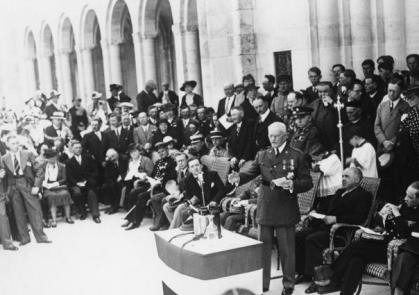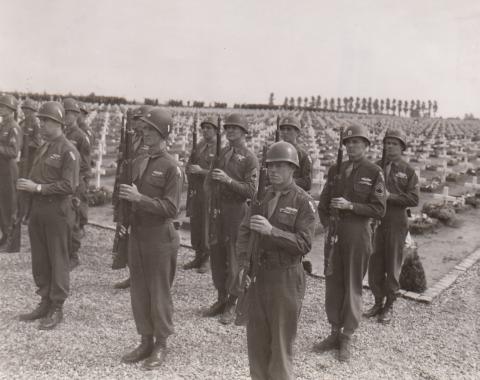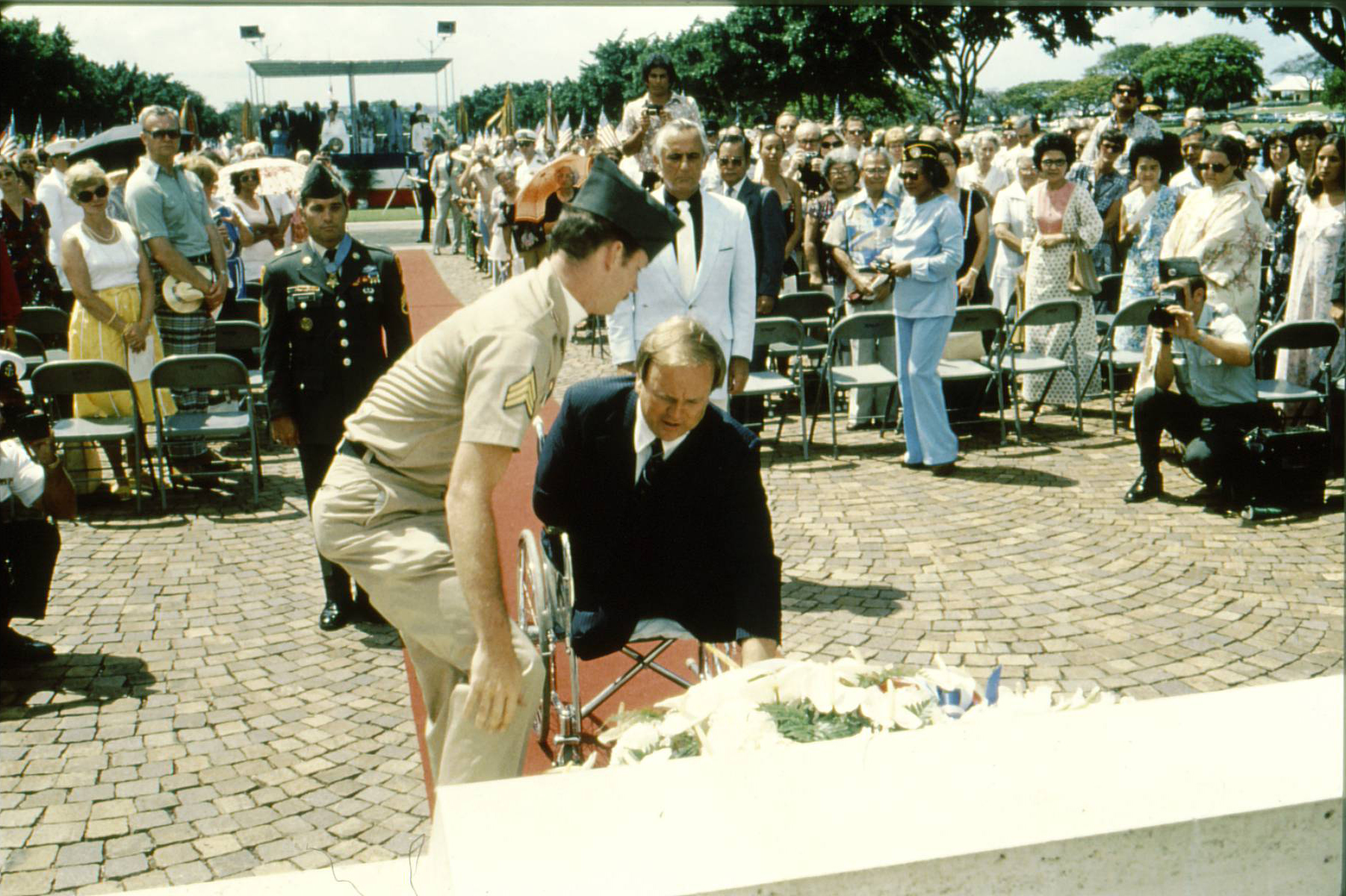This year, the American Battle Monuments Commission is celebrating its centennial, having been established on March 4, 1923. Throughout its history, ABMC has been proud to honor and recognize fallen U.S. service members with Memorial Day events at its cemeteries and memorials. Well attended by American and local dignitaries and the public, these ceremonies highlight the legacy of the fallen in our burial plots and walls of the missing as well as ABMC’s eternal promise to remember and honor them. ABMC has had some notable Memorial Days over the last 100 years, some occurring at sites that pre-date the official establishment of ABMC.
Memorial Day 1919, a mere seven months after the end of the war, saw the first observances at what would become the ABMC permanent cemeteries. President Woodrow Wilson, in Paris since the previous January for the Peace Conference, gave a dedicatory address at Suresnes. Harkening back to the holiday’s origins as ‘Decoration Day’ following the American Civil War, the temporary wooden grave markers were decorated with floral wreaths for the occasion.

Simultaneously, a ceremony was held at the Romagne cemetery that would become ABMC’s Meuse-Argonne American Cemetery. Still in France following WWI, Gen. John Pershing attended the ceremony and gave the dedicatory speech. Foreshadowing the mission of ABMC, Pershing noted that “the cemetery will always be a sacred plot…consecrated as a shrine where future generations of men who love liberty may come to do homage.”
Memorial Day 1937 saw special ceremonies as the six ABMC cemeteries in France were dedicated simultaneously. These ceremonies were simple, largely following the pattern of the Memorial Day events held at the cemeteries in the preceding years with a larger, more elaborate dedication ceremony for the World War I commemorative program held later, in August 1937, at Montfaucon Monument. For the most part, the official parties and attendees were French and American dignitaries and veterans residing overseas, but General Pershing did return to Meuse-Argonne, reprising his role from 18 years earlier. Also of note, the dedicatory address at the Somme ceremony was Florence Becker, president general of the Daughters of the American Revolution and the first woman to give a Memorial Day address at an ABMC cemetery. In his address to the audience at Suresnes, the vice premier of France noted the friendship and bonds between the allies, “the faithful and grateful salute of France to the memory of the valiant sons of America who lie asleep forever in our soil.”

The arrival of World War II was only two years after the annual Memorial Day celebrations at the World War I cemeteries, most of which fell under German occupation after the invasion of France in 1940. Brookwood American Cemetery was the only site to hold traditional Memorial Day ceremonies throughout the war. The 1941 ceremony included attendance from Clementine Churchill, the wife of Prime Minister Winston Churchill, as well as an estimated crowd of 800 -almost entirely British.
The end of the War in Europe a few weeks before Memorial Day allowed for impromptu ceremonies at many of the temporary cemeteries established across the continent during the war. At Margraten, the future Netherlands American Cemetery, a simple ceremony was held by the troops of the Ninth Army, many of whose comrades were buried in the surrounding plots. An address was given by Lt. Gen. William H. Simpson, commanding general of the Ninth Army, to the assembled troops and Dutch citizens, and a wreath was laid at the grave of an unknown soldier before invocations were given by Catholic, Protestant, and Jewish Chaplains.

Over 40 years after the dedication of the World War I cemeteries, Memorial Day witnessed another ABMC dedication, this time the expansion of the Honolulu Memorial in 1980. Two courts were added to the Memorial to recognize the over 2,500 missing from the Vietnam War. As part of the ceremony, a wreath was laid by Max Cleland, a Vietnam Veteran, and head of the Department of Veterans Affairs at the time of the ceremony. Cleland would later serve as the Secretary of ABMC (2009-2017).
The ceremonies mentioned above are only a tiny fraction of the hundreds of Memorial Day ceremonies hosted by AMBC over its first century, and even beyond those ceremonies the spirit of Memorial Day is kept alive daily by ABMC staff, whose promise is to preserve the legacy of the service members buried in our grave plots and engraved on the walls of the missing.

__________
Sources:
ABMC Historical Services contributed to this article.
 An official website of the United States government. Here's how you know.
An official website of the United States government. Here's how you know. 